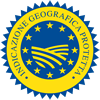Description
The Fagiolo Cuneo PGI refers to waxy pods ready for shelling and dried beans belonging to the species Phaseolus vulgaris L. and Phaseolus coccineus, deriving from the ecotypes Bianco di Bagnasco, Vedetta, Billò, Corona, Stregonta, Bingo, Rossano, Barbarossa, Solista and Millenium.
Production Area
The production area of Fagiolo Cuneo PGI is within numerous municipalities in the Province of Cuneo, in the Piedmont region.
Production Method
The seeds are planted between April and July. A unique and traditional method is used to support the plants while they are growing: two to four bean poles are tied together at the top to form a kind of “tepee”. The “tepees” are then connected to each other with a horizontal cord that links the point where the bean poles are tied together at the top, thereby creating a stronger and more rigid structure. The harvest takes place between May and November. The Vedetta ecotype or the Stregonta, Bingo, Rossano, Solista, Millenium and Barbarossa varieties are used to produce the waxy pods (fresh), while the Bianco di Bagnasco ecotype or the Billò or Corona varieties are used to produce the dried beans, which are harvested when the plant has completely withered.
Appearance and Flavour
The waxy Fagiolo Cuneo PGI pod has a very distinctive coloration with dark red streaks, while the bean is cream with pinkish-red streaks. The Billò variety of dried bean is cream and the Corona and Bianco di Bagnasco varieties are white, and they all have brownish-purple streaks. The seed is very fleshy and has a thin, delicate skin.
History
The commercialisation of Cuneo beans dates back to the 19th century, as evidenced in several market lists found in the Town Hall of Centallo. A regulation sanctioned in 1894 by the Cuneo Town Council reveals the existence of an ad hoc market for the sale of these beans, which due to their distinctive characteristics already cost more than common beans. This production has developed continuously over the last fifty years, so much so that it is traditionally sold in specifically established markets. The now famous Sagra di S. Sereno, which still takes place every year in the San Rocco Castagnaretta district of Cuneo, is proof of how important the Fagiolo Cuneo PGI is for the area.
Gastronomy
Fagiolo Cuneo PGI is best kept in a cool, dry place. It is an excellent ingredient for making soups and goes extremely well with garlic, lard, leeks, potatoes and chilli pepper, a combination that is used in a few typical recipes, including Piedmontese and dried Fagioli Cuneo PGI bean soup with leeks. Its high iron content makes it an ideal alternative to pasta and bread. The dried bean should be soaked in water for at least 12 hours before cooking, whereas the fresh bean can be cooked immediately after being shelled. Cooking times are variable, but usually one hour is enough.
Marketing
The product is marketed as Fagiolo Cuneo PGI. It is sold fresh (waxy to shell) or as dried beans. The waxy variety is packaged in special plastic or cardboard packets, or in sealed packing made from food-grade materials (trays, cartons, bags and similar). The dried seeds are sold in suitable packing or packets with a weight varying from 100 g to 25 kg. The fresh product is available from May and November, while the dried bean can be found year-round.
Distinctive Features
Both the dried bean and the waxy pod of the Fagiolo Cuneo PGI have an excellent consistency. The seed is also particularly rich in iron and protein, while the distinctive colouration of the waxy bean is due to the daily thermal excursions which, together with the intense light, favours anthocyanin synthesis.















